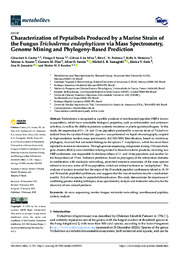Characterization of peptaibols produced by a marine strain of the fungus Trichoderma endophyticum via Mass Spectrometry, genome mining and phylogeny-based prediction.
Characterization of peptaibols produced by a marine strain of the fungus Trichoderma endophyticum via Mass Spectrometry, genome mining and phylogeny-based prediction.
Autoria: CASTRO, G. S.; SOUZA, T. F.; SILVA, G. F. da; PEDROSO, R. C. N.; MENEZES, K. S.; SOARES, M. A.; DIAS, G. M.; SANTOS, A. O.; YAMAGISHI, M. E. B.; FARIA, J. V.; JANUÁRIO, A. H.; KOOLEN, H. H. F.
Resumo: Abstract. Trichoderma is recognized as a prolific producer of nonribosomal peptides (NRPs) known as peptaibols, which have remarkable biological properties, such as antimicrobial and anticancer activities, as well as the ability to promote systemic resistance in plants against pathogens. In this study, the sequencing of 11-, 14- and 15-res peptaibols produced by a marine strain of Trichoderma isolated from the ascidian Botrylloides giganteus was performed via liquid chromatography coupled to high-resolution tandem mass spectrometry (LC-MS/MS). Identification, based on multilocus phylogeny, revealed that our isolate belongs to the species T. endophyticum, which has never been reported in marine environments. Through genome sequencing and genome mining, 53 biosynthetic gene clusters (BGCs) were identified as being related to bioactive natural products, including two NRP-synthetases: one responsible for the biosynthesis of 11- and 14-res peptaibols, and another for the biosynthesis of 15-res. Substrate prediction, based on phylogeny of the adenylation domains in combination with molecular networking, permitted extensive annotation of the mass spectra related to two new series of 15-res peptaibols, which are referred to herein as "endophytins". The analyses of synteny revealed that the origin of the 15-module peptaibol synthetase is related to 18, 19 and 20-module peptaibol synthetases, and suggests that the loss of modules may be a mechanism used by Trichoderma species for peptaibol diversification. This study demonstrates the importance of combining genome mining techniques, mass spectrometry analysis and molecular networks for the discovery of new natural products.
Ano de publicação: 2023
Tipo de publicação: Artigo de periódico
Unidade: Embrapa Amazônia Ocidental
Observações
1 - Por padrão são exibidas publicações dos últimos 20 anos. Para encontrar publicações mais antigas, configure o filtro ano de publicação, colocando o ano a partir do qual você deseja encontrar publicações. O filtro está na coluna da esquerda na busca acima.
2 - Para ler algumas publicações da Embrapa (apenas as que estão em formato ePub), é necessário ter, no celular ou computador, um desses softwares gratuitos. Sistemas Android: Google Play Livros; IOS: iBooks; Windows e Linux: software Calibre.
Acesse outras publicações
Acesse a Base de Dados da Pesquisa Agropecuária (BDPA) para consultar o acervo completo das bibliotecas da Embrapa.

